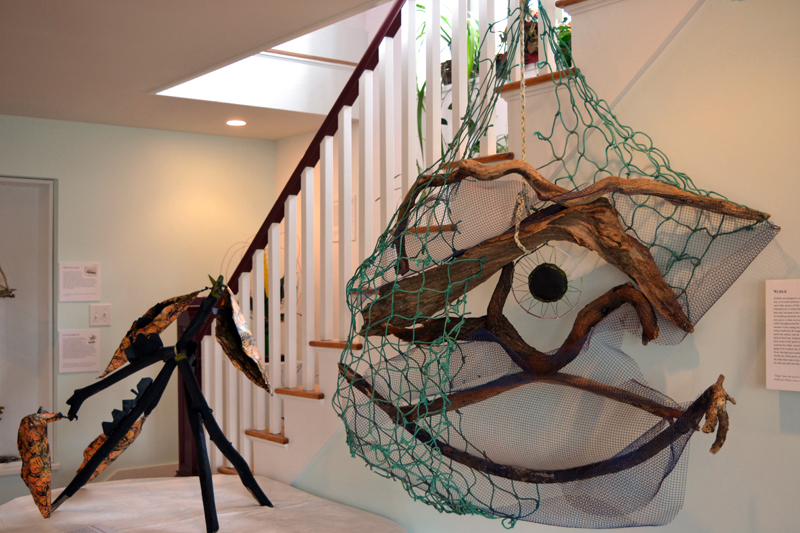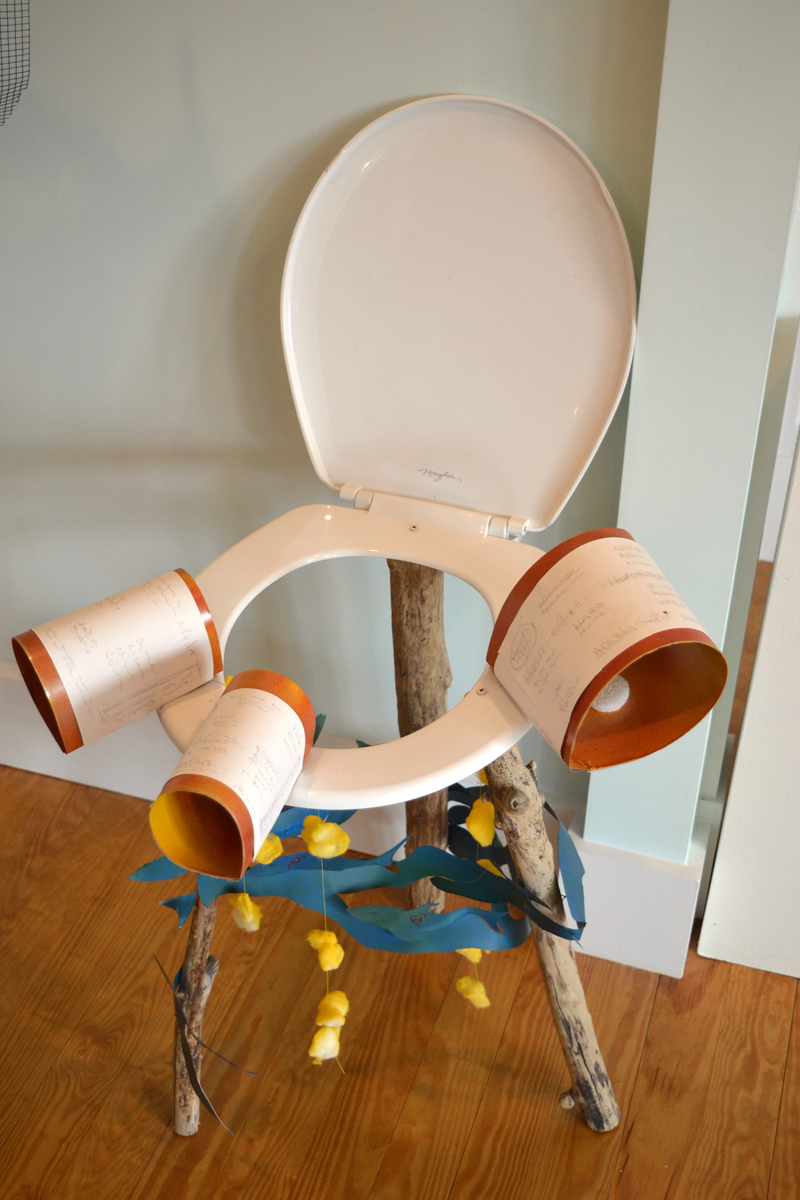
Damariscotta artist Marnie Sinclair (left) and her friend Deb Poor are all smiles in the dining-room-turned-art gallery on the first floor of Poor’s River Road home. (Christine LaPado-Breglia photo)
Damariscotta artist Marnie Sinclair, whose art gallery and studio is one of the four Bristol Road Galleries, is known for her bronze sculptures, her pastel drawings, and, increasingly, her environmentally focused artwork. Since April 21, Sinclair’s work has been on display at the home of her friend Deb Poor, who turned the lower floor of her beautiful two-story house in Newcastle into an art gallery for Sinclair’s show, which is titled “Balance & Imbalance.”
“I wouldn’t do this for most other artists,” Poor said, adding that the “green” environment of her LEED-certifiable home and the environmental focus of Sinclair’s art “just works together.”
“And I love Marnie’s art!” said Poor.
Sinclair, a grandmother of five, expresses a deep concern for the preservation of nature and the environment. In her book, “Balance & Imbalance: A Celebration of Nature and a Call to Action,” she explains some of what motivates her: “I’m an artist and a grandmother, and my views and passions come from that place. And so it was that in 2010 I set out to try and make sense of climate change. I decided to make one piece of abstract art a week for 52 weeks that related directly to environmental degradation issues and more specifically, to climate change. I researched the science behind each story and presented the art and the story together.”

From left: Eco-artist Marnie Sinclair’s large pieces “Monarch Butterflies” and “Nudge” grace the area near the stairs at Deb Poor’s house-turned-gallery in Newcastle. (Christine LaPado-Breglia photo)
In her current show, Sinclair offers numerous pieces of hanging and standing abstract sculpture accompanied by the story each piece tells.

Eco-conscious artwork by Marnie Sinclair on display in the Newcastle home of Deb Poor includes “Downstream,” which depicts the negative effect that pharmaceutical-drug-flushing and urinating after taking medications have on water and wildlife. (Christine LaPado-Breglia photo)
“The Pitcher and Bat,” a shiny metal-and-wire wall-hung piece, is accompanied by this rather amazing story: “The pitcher plant from Borneo has developed a unique symbiotic relationship with bats. The carnivorous plant attracts bats, not to eat them but to ingest the nutrients found in their guano. The bat in exchange is provided with a safe, cozy place to rest. This give-and-take arrangement is not the only interesting aspect of their relationship: Unlike other plants that send out pheromones to communicate, this pitcher plant is the only plant that uses echolocation to guide bats to it, similar to the sonar the bats use to navigate.” The story is even more interesting when Sinclair tells it as she stands next to the piece, motioning with excitement and wonder, as she did when I visited the house-gallery recently.
Other pieces in Sinclair’s show are similarly fascinating, such as “Grouper and the Moray Eel,” a fabric-and-driftwood piece focused on the “balanced, cooperative relationship” that the two creatures have when it comes to hunting for food, and “Acidification,” a large floor-standing piece made from wire, driftwood, and theater gel.
“The idea is to get as many people as possible in here to raise awareness about climate change and what we’re doing to the planet,” Sinclair said.
An open-house party will be held at the exhibit at Poor’s house from 5-7 p.m. on Friday, May 19. A final open-house event to view Sinclair’s art will be held on Sunday, May 21 from noon to 4 p.m. Sinclair will be present at both events. The show will close on Tuesday, May 23.
Poor’s striking Madeira-red house with white trim is located at 40 River Road, Newcastle, on the bank of the Damariscotta River. Those wanting to see the show other than during the two open-house events should call Poor at 380-7047 to make arrangements.
“The business of art is to reveal the relation between man and his environment.” – David Herbert Lawrence
(Email me at clbreglia@lcnme.com or write me a letter in care of The Lincoln County News, P.O. Box 36, Damariscotta, ME 04543. I love to hear from readers.)



